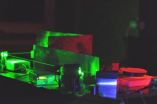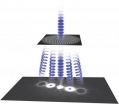(Press-News.org) An international research team working with National Institute of Standards and Technology (NIST) scientists at the Hollings Marine Laboratory (HML) in Charleston, S.C., has suggested for the first time that mercury cycling in the flora and fauna of the Arctic may be linked to the amount of ice cover present. Their study* is the latest work reported from the Seabird Tissue Archival and Monitoring Project (STAMP), a multiyear joint effort of NIST, the U.S. Fish and Wildlife Service (USFWS), the U.S. Geological Survey (USGS) and the Bureau of Indian Affairs to track trends in pollutants in northern marine environments using seabird eggs.
Overall mercury levels in northern environments have been documented for some 20 years. However, the new study marks the first time that the tracking has been done using a sophisticated analysis of mercury isotopes (forms of the same atom that have different atomic masses) and an effect called "mass-independent fractionation" or MIF.
MIF is a relatively unusual change in the relative abundance of different isotopes of the same element (fractionation) that can be the result of photochemical reactions. Determining the relative amount of the MIF isotopes of mercury is considered valuable because the data can be used to trace the reactions in nature that led to the fractionation—and in turn, provide a better understanding of how the reactions work and how they impact the cycling of mercury in the environment.
Ultraviolet radiation from sunlight can fractionate mercury on the ocean surface via a process known as photodegradation. Laboratory research has shown that this reaction preferentially selects for some isotopes of mercury to move into the atmosphere while others become more abundant in the ocean. Plankton absorb the water-borne mercury, fish eat the plankton, and finally, sea birds eat the fish and pass the ingested mercury into their eggs. Therefore, the eggs are key tissues for mercury monitoring. For the current study, field groups made up of biologists and native Alaskans (for whom seabird eggs are a food source) collected eggs laid by murres, a bird species that nests year-round in three coastal regions of Alaska.
Examination of murre eggs from the northernmost nesting areas where sea ice exists all year long revealed lower amounts of MIF mercury isotopes than in eggs collected from sites in southern Alaska where there is no ice cover. Conversely, the mercury in eggs from nests near ice-free seas reflected significantly greater effects of mass-independent fractionation. The researchers believe that ice prevents UV light from reaching the mercury, effectively suppressing photodegradation.
With the potential for global warming to dramatically reduce Arctic sea ice in the future, the relationship between ice cover and distribution of mercury in the environment is obviously an important one to investigate further. The international research team next plans to use its seabird egg isotope monitoring system to distinguish the sources of mercury contamination in coastal areas to those from oceanic waters. For this study, eggs will be collected along Alaska's Norton Sound that receives runoff from the Yukon River—including high concentrations of cinnabar, the ore from which mercury is derived—and compared to eggs from remote island colonies that are more influenced by atmospheric and oceanic mercury sources.
INFORMATION:
Teaming on this study with NIST scientists at the HML were staff from the USFWS Alaska Maritime National Wildlife Refuge (Homer, Alaska), Environment Canada (Saskatoon, Saskatchewan, Canada), the Labotatoire des Mécanismes et Transferts en Géologie (Toulouse, France) and the Institut Pluridisciplinaire de Recherche sur l(Environnement et les Matreriaux (Pau, France). Financial support for the research was provided by NIST, the French Centre National de la Recherche Scientifique and a grant from the French Agence Nationale de Recherche.
The HML is a unique partnership of governmental and academic agencies including NIST, NOAA's National Ocean Service, the South Carolina Department of Natural Resources, the College of Charleston and the Medical University of South Carolina.
* D. Point, J.E. Sonke, R.D. Day, D.G. Roseneau, K.A. Hobson, S.S. Vander Pol, A.J. Moors, R.S. Pugh, O.F.X. Donard and P.R. Becker. Methylmercury photodegradation influenced by sea ice over in Arctic marine ecosystems. Nature Geoscience. Published online Jan. 16, 2011.
Eggs show arctic mercury cycling may be linked to ice cover
2011-01-21
ELSE PRESS RELEASES FROM THIS DATE:
NIST advances single photon management for quantum computers
2011-01-21
The quantum computers of tomorrow might use photons, or particles of light, to move around the data they need to make calculations, but photons are tricky to work with. Two new papers* by researchers working at the National Institute of Standards and Technology (NIST) have brought science closer to creating reliable sources of photons for these long-heralded devices.
In principle, quantum computers can perform calculations that are impossible or impractical using conventional computers by taking advantage of the peculiar rules of quantum mechanics. To do this, they need ...
Real-world graphene devices may have a bumpy ride
2011-01-21
Electronics researchers love graphene. A two-dimensional sheet of carbon one atom thick, graphene is like a superhighway for electrons, which rocket through the material with 100 times the mobility they have in silicon. But creating graphene-based devices will be challenging, say researchers at the National Institute of Standards and Technology (NIST), because new measurements show that layering graphene on a substrate transforms its bustling speedway into steep hills and valleys that make it harder for electrons to get around.
In a new article in Nature Physics,* NIST ...
Stretching the truth: JILA biophysicists help unravel DNA stretching mystery
2011-01-21
Using a new experimental test structure, biophysicists at JILA have unraveled part of a 15-year mystery in the mechanics of DNA—just how the molecule manages to suddenly extend to almost twice its normal length. The new test structure should support research on DNA elasticity as a standard for tiny forces and help refine studies of how drugs and other substances bind to DNA.
In a new paper in the Journal of the American Chemical Society,* JILA scientists disprove a leading explanation for DNA overstretching, a curious behavior in which the molecule's double helix structure ...
Identifying factors in atrazine's reduced weed control
2011-01-21
MADISON, WI, JANUARY 19, 2011 – Invasive broadleaf weeds can destroy corn crops and fallow fields. Farmers use the chemical atrazine in herbicides to protect their plants. Despite atrazine's controversial environmental impacts, it can provide long term residual control of many weed species. However, the loss of atrazine's effectiveness has been a challenge for farmers in northeastern Colorado.
In a collaborative study between scientists at the USDA-Agricultural Research Service Water Management Research Unit and Colorado State University, soil samples were collected from ...
NIST puts a new twist on the electron beam
2011-01-21
Electron microscopes are among the most widely used scientific and medical tools for studying and understanding a wide range of materials, from biological tissue to miniature magnetic devices, at tiny levels of detail. Now, researchers at the National Institute of Standards and Technology (NIST) have found a novel and potentially widely applicable method to expand the capabilities of conventional transmission electron microscopes (TEMs). Passing electrons through a nanometer-scale grating, the scientists imparted the resulting electron waves with so much orbital momentum ...
Study yields better turbine spacing for large wind farms
2011-01-21
Large wind farms are being built around the world as a cleaner way to generate electricity, but operators are still searching for the most efficient way to arrange the massive turbines that turn moving air into power.
To help steer wind farm owners in the right direction, Charles Meneveau, a Johns Hopkins fluid mechanics and turbulence expert, working with a colleague in Belgium, has devised a new formula through which the optimal spacing for a large array of turbines can be obtained.
"I believe our results are quite robust," said Meneveau, who is the Louis Sardella ...
Are positive emotions good for your health in old age?
2011-01-21
The notion that feeling good may be good for your health is not new, but is it really true? A new article published in Current Directions in Psychological Science, a journal of the Association for Psychological Science, reviews the existing research on how positive emotions can influence health outcomes in later adulthood.
"We all age. It is how we age, however, that determines the quality of our lives," said Anthony Ong of Cornell University, author of the review article. The data he reviews suggest that positive emotions may be a powerful antidote to stress, pain, ...
With chemical modification, stable RNA nanoparticles go 3-D
2011-01-21
CINCINNATI—For years, RNA has seemed an elusive tool in nanotechnology research—easily manipulated into a variety of structures, yet susceptible to quick destruction when confronted with a commonly found enzyme.
"The enzyme RNase cuts RNA randomly into small pieces, very efficiently and within minutes," explains Peixuan Guo, PhD, Dane and Mary Louise Miller Endowed Chair and professor of biomedical engineering at the University of Cincinnati (UC). "Moreover, RNase is present everywhere, making the preparation of RNA in a lab extremely difficult."
But by replacing a ...
Louisiana Tech University professor visits India as part of US delegation on energy issues
2011-01-21
RUSTON, La. – While most people were busy shopping during the holiday season, Dr. Daniela Mainardi, associate professor of chemical engineering at Louisiana Tech University and member of the Institute for Micromanufacturing, was preparing for a trip that would take her half way around the world.
As part of a joint effort, Mainardi, together with Virendra Mathur from the University of New Hampshire, and Suddhasatwa Basu and Shantanu Roy from The Indian Institute of Technology-Delhi, was in charge of organizing a workshop titled, "Energy and Environment: Challenges and ...
Latest American Chemical Society podcast: Biodegradable foam from milk protein and clay
2011-01-21
WASHINGTON, Jan. 20, 2011 — The latest episode in the American Chemical Society's (ACS) award-winning podcast series, "Global Challenges/Chemistry Solutions," focuses on development of a new ultra-light biodegradable foam plastic material made from two unlikely ingredients: The protein in milk and ordinary clay.
The material could be used in numerous products, researchers report in the ACS' Biomacromolecules, a monthly journal. The finding comes amid ongoing concern about plastic waste accumulating in municipal landfills, and reliance on imported oil to make plastics.
David ...



